
![]()
~ THE BEANEY INSTITUTE & ROYAL MUSEUM ~
18 HIGH STREET, CANTERBURY
Re-opened September 2012
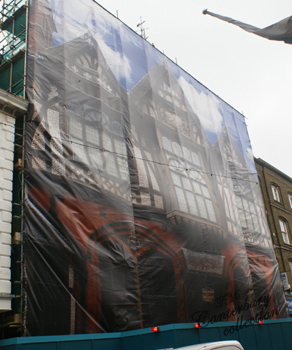
The Beaney under construction
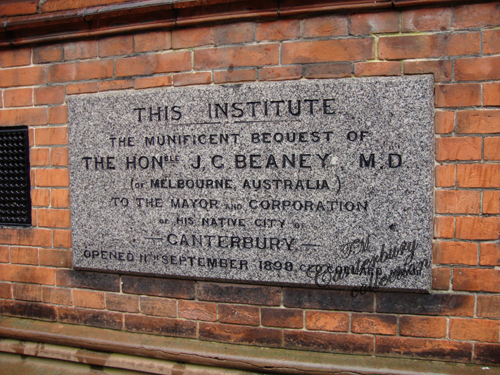
The building opened on September 11th, 1899, and was partly paid for by a legacy of £10,000 left to the City by the late J.D. Beaney, M.D. of Melbourne, Australia who had been born in Canterbury. He left the money for "the erection and endowment of an institute for working men." It contains a free library and reading rooms on the ground floor, a museum above and a natural history section in the basement.
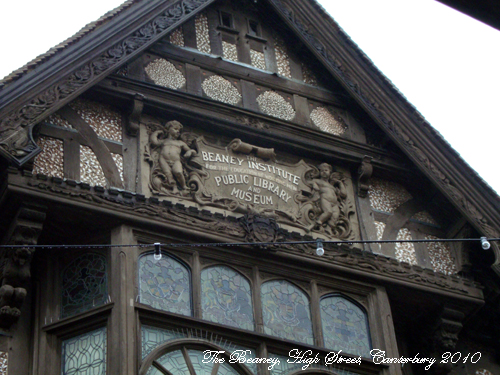
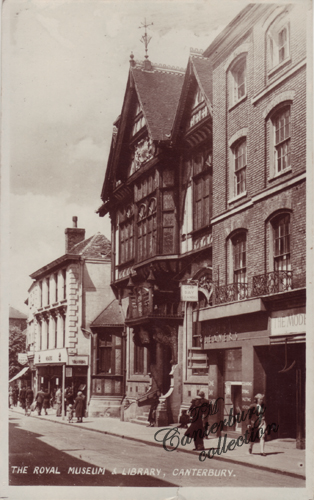
The Beaney Institute replaced the Philosophical and Literary Institute in Guildhall Street which the City had bought in 1846.
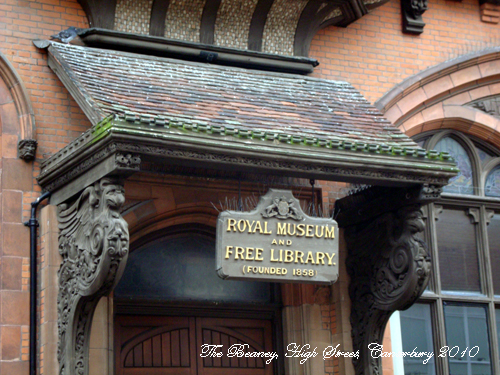
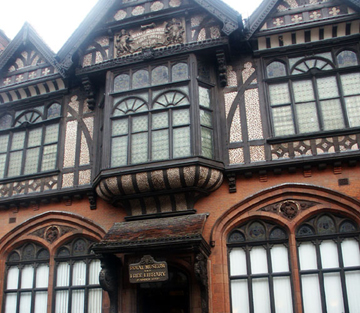
"The Beaney Institute & Royal Museum"
From a list of Subscribers to Freeman of Canterbury by J. M. Cowper 1903 - The Canterbury Museum, Canterbury
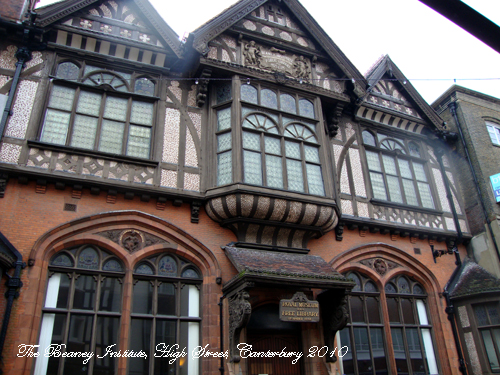
The Beaney Institute, for the education of working men, in High Street, with which is combined a public library and museum, was erected in 1897-99, at a cost, including land and furnishings, of about £15,000, of which £10,000 was left for the purpose by the late Dr. Beaney, a native of Canterbury, who died in 1892 in Melbourne, Australia, and £1050 was given by Joshua Cox esq. towards the furnishing: the building is in the Renaissance style, from designs by Mr. A. N. Camplell A.M.I.C.E. and comprises a spacious suite of rooms devoted to newspapers and journals, a magazine room, lending and reference libraries, all on the ground floor, the upper floor being devoted to a museum and art gallery; in the basement is the natural history section, storage and workroom; the balance of cost was provided by the Corporation. The Canterbury Museum and Public Library, founded in 1858, were removed from Guildhall street in 1898 to this building, and the library now has about 12,000 volumes. 1913
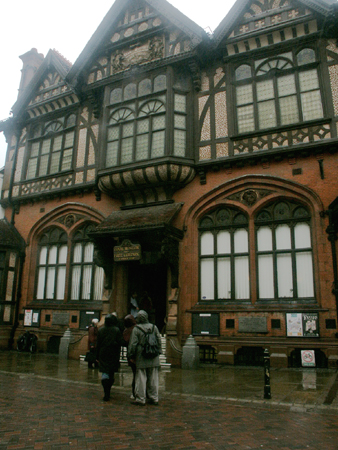 ______
______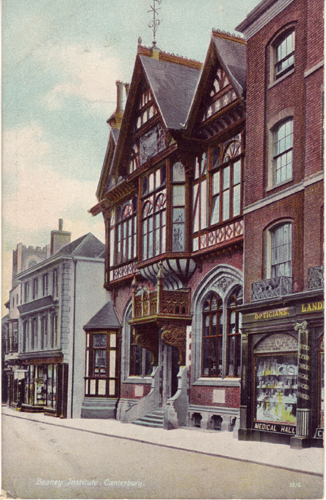
Now the Royal Museum & Art Gallery, also with the Buffs Regimental Museum.
1903 Henry Thomas Mead was the assistant curator and librarian, Henry Fielding the secretary, and F. Bennett-Goldney Esq. F.S.A. hon. curator.
1913 Henry Fielding Secretary; Henry Thomas Mead, deputy curator & librarian; F. Bennett-Goldney esq. M.P., F.S.A. hon. curator.
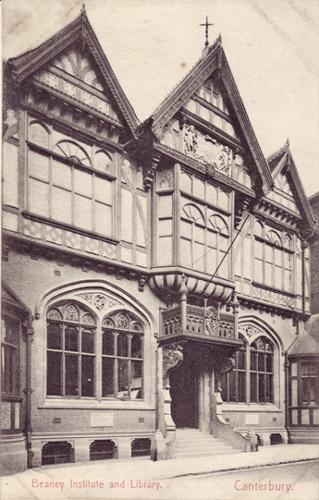
"The Beaney Institute & Library"
A collection of animals and birds bequeathed by the late S. R. Lushington Esq.
The Hammond collection of birds, bequeathed in 1903
The De Zoete collection of pictures - English and Dutch artists, presented by G. F. de Zoete esq. in 1906
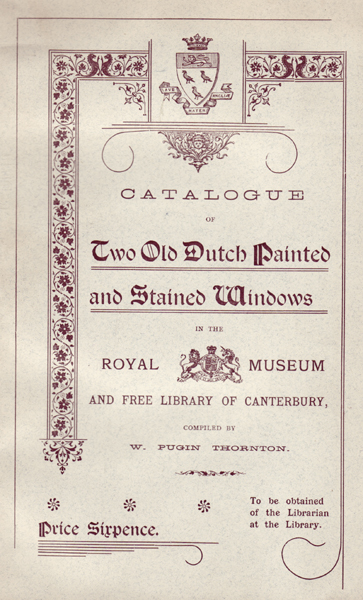
"Catalogue of Two Old Dutch Painted and Stained Windows", in the Royal Museum and Free Library of Canterbury
printed 1899
Museum Committee
The Mayor
George Collard, Esq.
Alderman
William W. Mason *Barton Fields retired Jeweller
Thomas Cross *3 Hanover Place, Retired Schoolmaster
W. Sanderson
Councillor
G. Dunn
Stephen Horsley *11 London Road, retired Civil Engineer
Frederick Kennett *Orchard Villa (New Street, St. Dunstan Within) retired Upholsterer
E. Lukey
W. H. Netherclift
W. J. Russell
Hon. Curator and Librarian
F. Bennett Goldney, Esq. (1865-1918)
Librarian
Mr. Alfred D. Blaxland *7 Hawks Lane, Dental Surgeon (D. maybe Denne)
Assistant Librarian
Mr. Henry J. Mead *2 Bertha Villas, Hanover Road, Public Librarian
Sub-Curator
Mr. James McConnell *49 Union Street, Assistant to Curator of the Beaney Museum
Secretary
Henry Fielding, Esq. *The Precincts, Solicitor
The Royal Museum and Free Library, both belonging to the Corporation are now permanently housed in the new building of the Beaney Institute, recently completed from designs by the City Surveyor, Mr. A. H. Campbell. The building which has a handsome half-timbered front facing High Street, near the Guildhall, has been partially paid for out of a legacy of £10,000 left to the City by the late Mr. Beaney, a native of Canterbury, who amassed a large fortune in Australia. According to the terms of his will, a number of his portraits were ordered to be hung in a conspicuous part of the building, and he originally intended that the money which he left to the City should be used to found an institute for the education of working-men. The Corporation, however, with the consent of the Charity Commissioners, have wisely added another five thousand pounds to the original sum, and erected the present building for the purposes of the already existing Free Library and Museum. By special permission of Her Majesty the Queen, the Museum which has been in existence since 1825, is now styled the Royal Museum.

It occupies the whole of the first floor of the new building, as well as a large room in the half basement used for the natural history collections, and is fitted throughout with electric light. The 18th century chandelier in the large room was originally from the Cathedral.
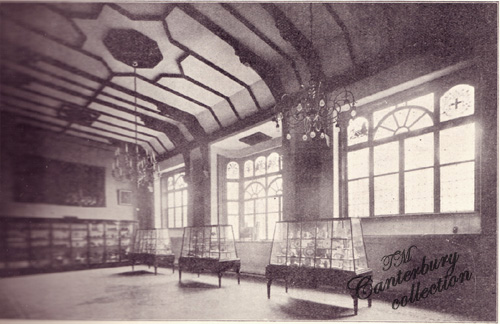
The mahogany cases with which the Museum is fitted were formerly in the British Museum; they have been rebuilt by Messrs. Cubitt and Col, and were paid for partly out of a legacy left to the museum by the late Miss Lawrence, and partly out of a gift of one hundred pounds given by W. Oxenden Hammond, Esq., of St. Albans Court, who has taken a particular interest in the Museum.
The Museum, though not on a large scale, contains many objects of remarkable rarity. Besides the Geological and Natural History Collections not yet arranged, the Museum contains a small ethnological collection, which includes three eligible specimens of Maori tattooed heads. Upstairs particular attention may be drawn to the collections of prehistoric implements, Roman and Anglo-Saxon antiquities found in Canterbury and Thanet and East Kent. Special notice should be taken of two Rune-stones found at Sandwich. The name, which has been read Raehaebul, is incised on the larger stone. Nothing is now perceptible on the smaller one, though both were probably inscribed with the names of those in whose memory they were erected. Professor Stephens, in his Old Northern Runic Monuments, considers these stones unique, and that they belong to the fourth or fifth century; being probably the oldest funeral blocks ever found in this country not belonging to a Celtic or Romano-British population. A nearly perfect specimen of an Anglo-Saxon glass vessel, with hollow, tear-like protuberances, from Reculver, is to be seen in the same room. Near the central window is St. Augustine's Chair, formerly in the chancel of the Church of Stanford Bishop, in Herefordshire. This chair is believed to be the one in which St. Augustine was seated when he received the British Bishops at Augustine's Oak. It was turned out of the church during the restorations many years ago, and was acquired by the late Dr. James Johnston, who had been aware of its existence and the tradition concerning it some forty years previously. It was presented to the Royal Museum in 1899, by his son, G. Cocks Johnson Esq., of Cheltenham.
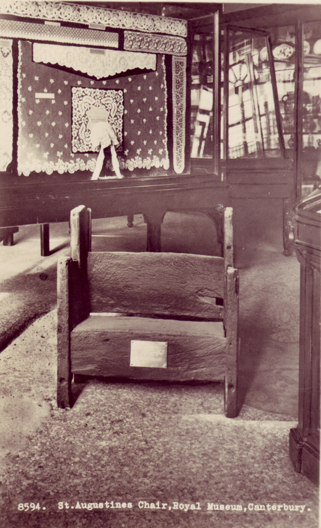
Close by is a 14th century chair taken from the Cathedral of Notre Dame at Rouen during the Revolution. This chair was originally in a well-known Collection in Paris, and is lent by the Hon. Curator.*
In the room adjoining may be seen the loan exhibition of ecclesiastical and other art from the Victoria and Albert Museum, and in the small room may been seen the celebrated Tinworth terra-cotas and a collection of modern Lambeth ware, kindly lent by Messrs. Doulton and Co. On the walls are two representative pictures by the well-known Canterbury artist, Sidney Cooper, R.A., and at the end of the large room a full-length portrait of the Princess Elizabeth, Queen of Bohemia, and daughter of James I, by Vandyke, (Mr. J. van Miereveldt?) and one of the original studies in oil of the "Wheel of Fortune," by Sir Edward Burde Jones, Bart., lent by the Hon. Curator* The Museum possesses an almost complete collection of engravings and prints of Old Canterbury, presented by Dr. Pugin Thornton, and in the library there are about forty similar prints presented by J. Henniker Heaton, Esq., M.P. In addition to these, the Museum is rich in engravings, the valuable Ingram collection of old Indian engravings and drawings having been presented last year by Ingram Godfrey, Esq., of Brooke House.
1899 HFC,B.A.D.
---------------
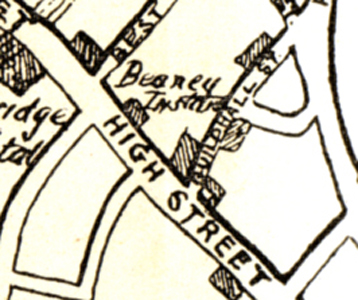
"The building itself opened 11th September, 1899, with its somewhat florid half-timber elevation, was partially paid for out of a legacy left to the City by a native of Canterbury, the late J.D. Beaney, M.D. (Melbourne) who amassed a large fortune in Australia. Main Gallery on the first floor:
In addition to the unique and well-known collections of Prehistoric, Roman and Anglo-Saxon antiquities by the late Mr. John Brent, Lieut.-Colonel Copeland, and the late Mr. Bennett-Goldney, there is to be seen a representative collection of Old English, Continental, and Oriental Porcelain containing many beautiful examples of the potter's art, bequeathed by the late John Irving, of Blackheath, Kent, 1915.
In the large case at the East end will be found many remarkable and beautiful specimens of Romano-British pottery, and the small but famous collection of Roman and Anglo-Saxon glass found in the neighbourhood of Canterbury and Faversham. Here also, are the two famous Jutish Rune stones, the oldest inscribed burial memorials ever found in Britain not belonging to a Celtic or Romano-British population. Although no inscription is now legible on the smaller block, the name Raehaebul may still be read, in incised Runic characters, on the larger stone.
Among the numerous other objects of interest in the same gallery special attention must be called to the ancient Burghmote Horn, with which the Corporation, down to the year 1835, were wont to be assembled. Mention of this horn is made in the reign of Henry III, when the Bailiffs were accused of "raising the Commonality by the sound of the horn to the number of 5,000." In the same case may be seen the municipal maces of the now extinct Corporation of Fordwich, which, with other specimens of ancient metal work and a rich collection of the extremely rare pilgrims' tokens, the small leaden brooches and other adornments worn by Canterbury Pilgrims to the shrine of St. Thomas, are among the most remarkable exhibits in the Museum.
Attention should be given to the Godfrey collection of old Italian and other engravings, presented with several works of art, by the late Mr. Ingram Godfrey, of Brook House."
------------------
Mrs. Scott Robertson has also given about 200 books relating to Kent, so that the Beaney Institute has now a large and valuable collection of works relating to Kent and Canterbury.
1957 there was an exhibit from July 6th to September 30th at the Institute for the Joseph Conrad Centenary, with his personal effects, books, and photo's of manuscripts, and sketches.
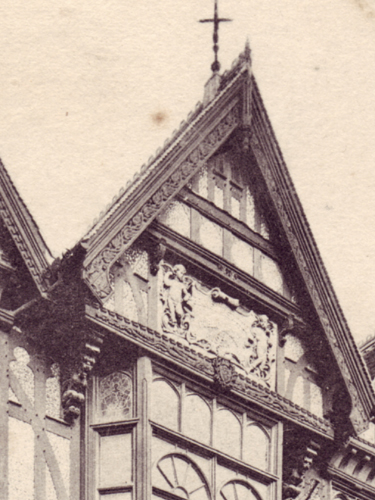
In 1975 St. Alphege church gave the ancient helmet on permanent loan to the Beaney Institution
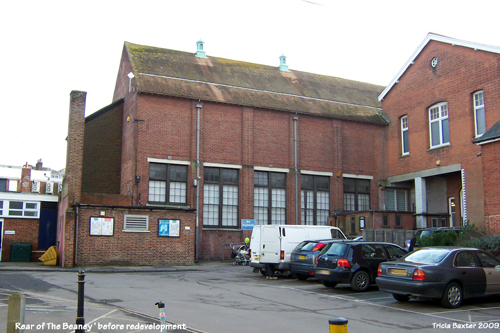
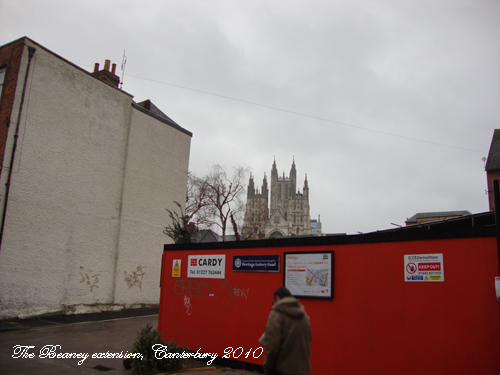
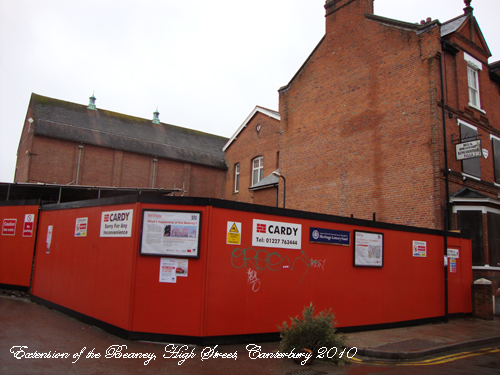
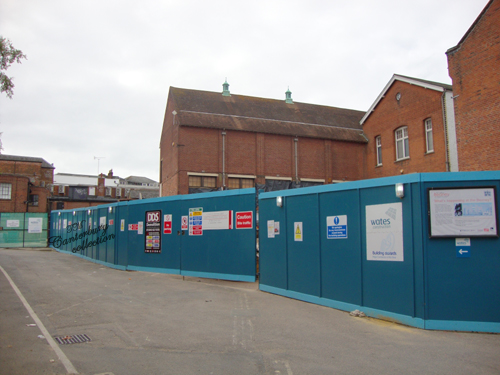
The Beaney under construction 2010
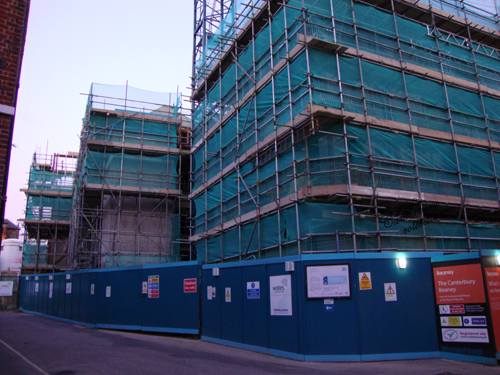
The Beaney under construction August 2011
© T. Machado 2007